Lexus IS250 2006 Do-it-yourself maintenance / LEXUS 2006 IS350/250 THROUGH APRIL 2006 PROD. (OM53508U) Owners Manual
Manufacturer: LEXUS, Model Year: 2006, Model line: IS250, Model: Lexus IS250 2006Pages: 433, PDF Size: 10.9 MB
Page 91 of 433
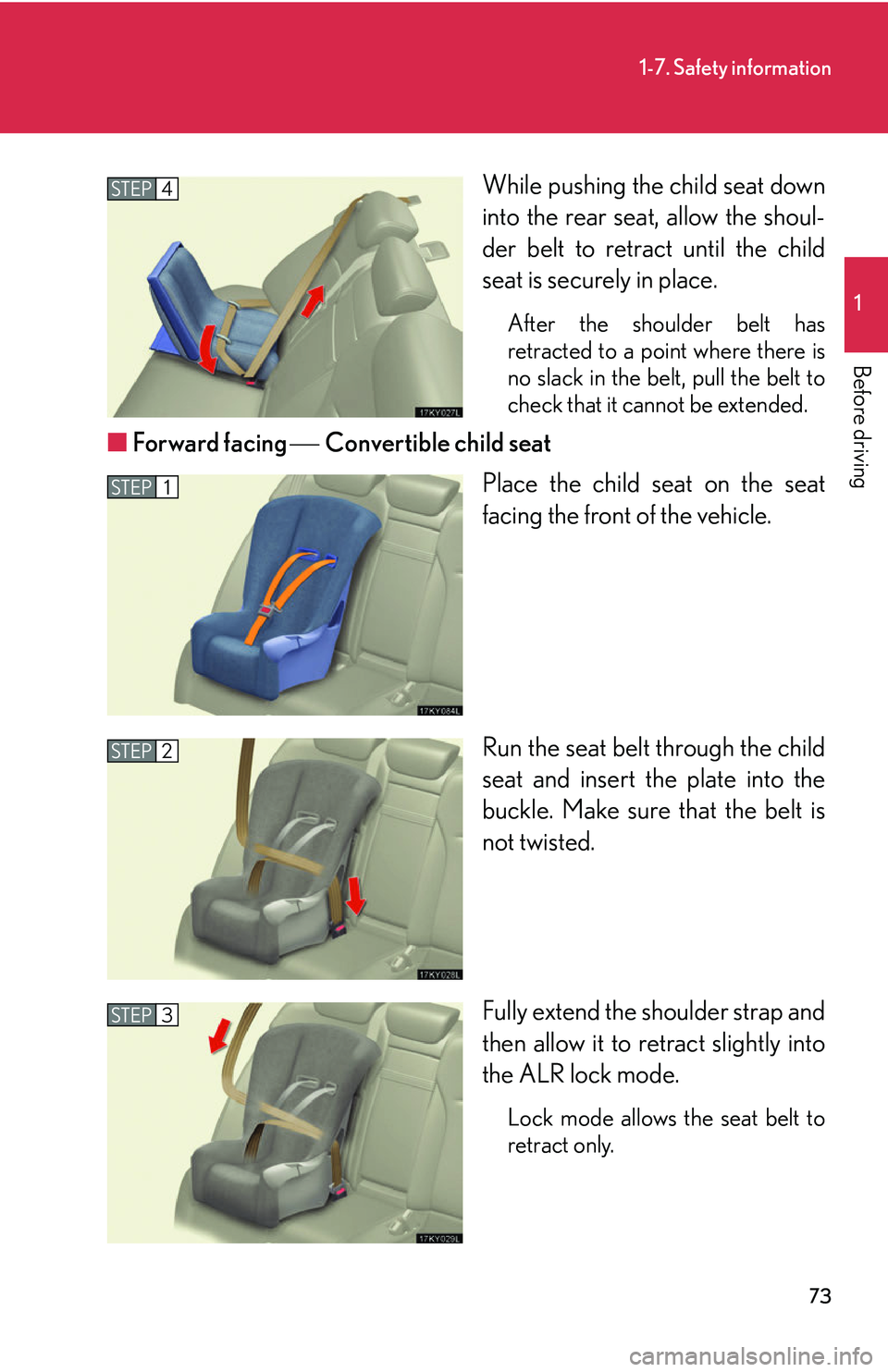
73
1-7. Safety information
1
Before driving
While pushing the child seat down
into the rear seat, allow the shoul-
der belt to retract until the child
seat is securely in place.
After the shoulder belt has
retracted to a point where there is
no slack in the belt, pull the belt to
check that it cannot be extended.
■Forward facing Convertible child seat
Place the child seat on the seat
facing the front of the vehicle.
Run the seat belt through the child
seat and insert the plate into the
buckle. Make sure that the belt is
not twisted.
Fully extend the shoulder strap and
then allow it to retract slightly into
the ALR lock mode.
Lock mode allows the seat belt to
retract only.
STEP4
STEP1
STEP2
STEP3
Page 92 of 433
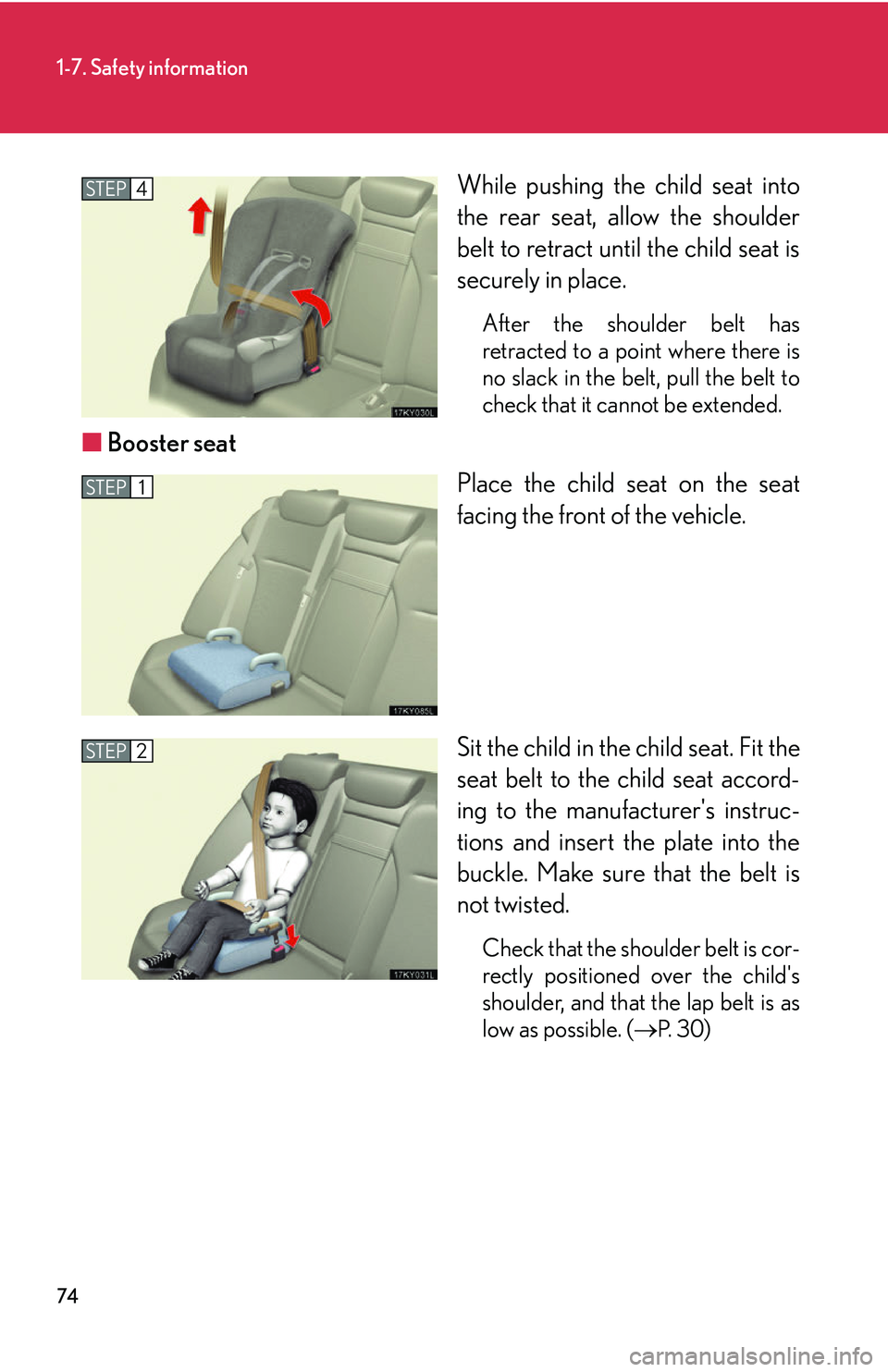
74
1-7. Safety information
While pushing the child seat into
the rear seat, allow the shoulder
belt to retract until the child seat is
securely in place.
After the shoulder belt has
retracted to a point where there is
no slack in the belt, pull the belt to
check that it cannot be extended.
■Booster seat
Place the child seat on the seat
facing the front of the vehicle.
Sit the child in the child seat. Fit the
seat belt to the child seat accord-
ing to the manufacturer's instruc-
tions and insert the plate into the
buckle. Make sure that the belt is
not twisted.
Check that the shoulder belt is cor-
rectly positioned over the child's
shoulder, and that the lap belt is as
low as possible. (
P. 3 0)
STEP4
STEP1
STEP2
Page 93 of 433
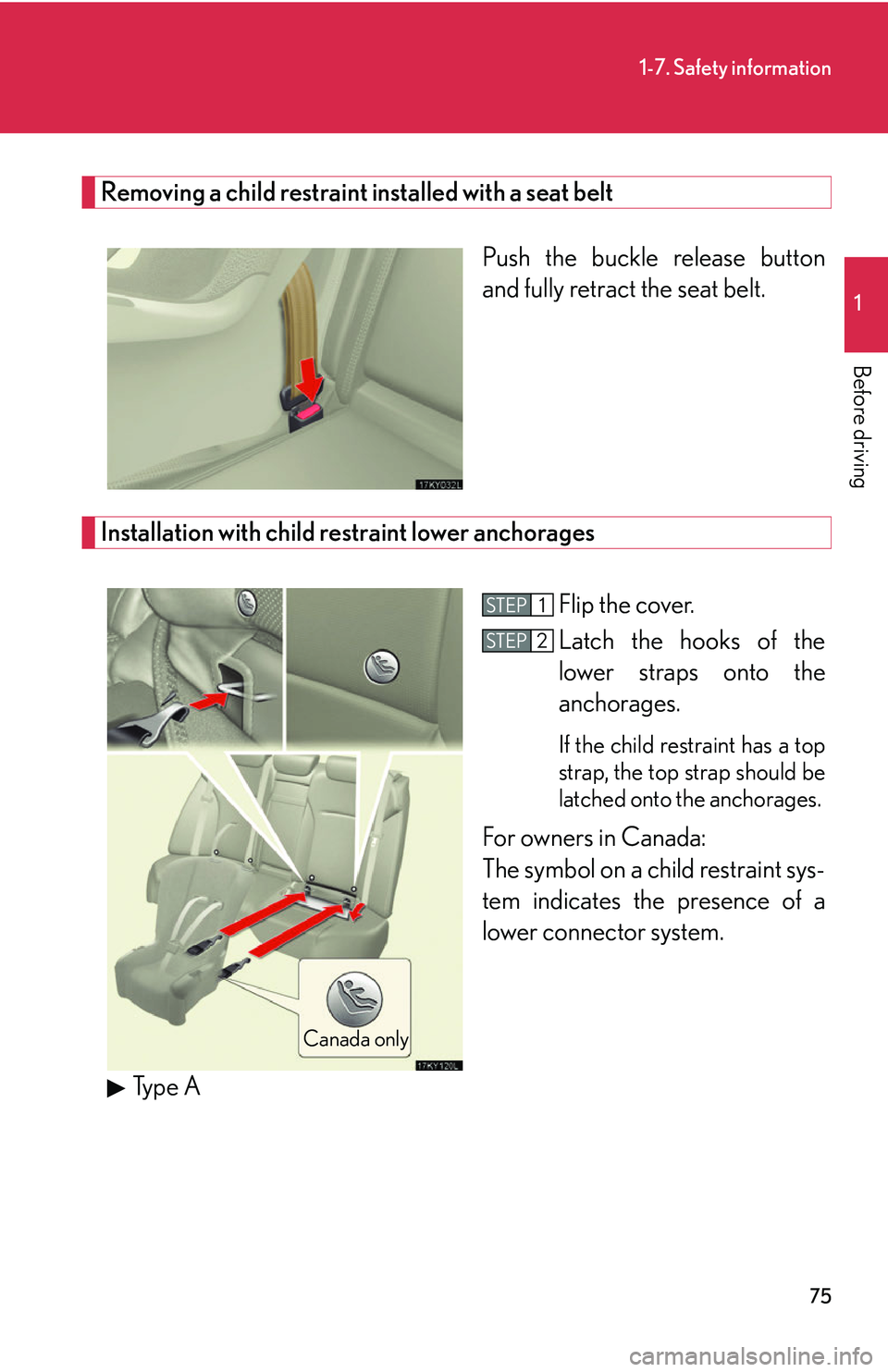
75
1-7. Safety information
1
Before driving
Removing a child restraint installed with a seat beltPush the buckle release button
and fully retract the seat belt.
Installation with child restraint lower anchorages
Flip the cover.
Latch the hooks of the
lower straps onto the
anchorages.
If the child restraint has a top
strap, the top strap should be
latched onto the anchorages.
For owners in Canada:
The symbol on a child restraint sys-
tem indicates the presence of a
lower connector system.
Canada only
Type A
STEP1
STEP2
Page 94 of 433
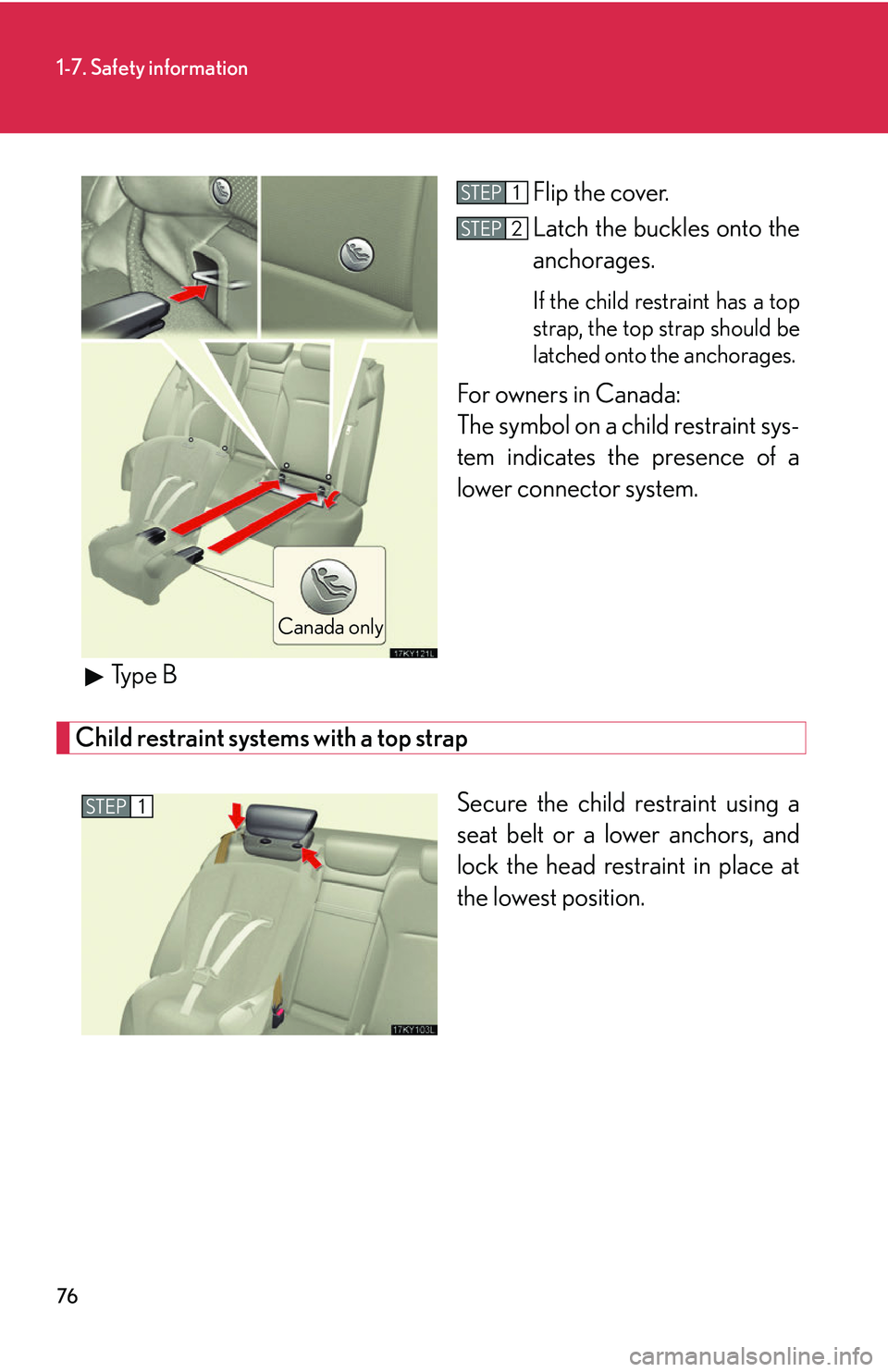
76
1-7. Safety information
Flip the cover.
Latch the buckles onto the
anchorages.
If the child restraint has a top
strap, the top strap should be
latched onto the anchorages.
For owners in Canada:
The symbol on a child restraint sys-
tem indicates the presence of a
lower connector system.
Child restraint systems with a top strapSecure the child restraint using a
seat belt or a lower anchors, and
lock the head restraint in place at
the lowest position.
Canada only
Type B
STEP1
STEP2
STEP1
Page 95 of 433
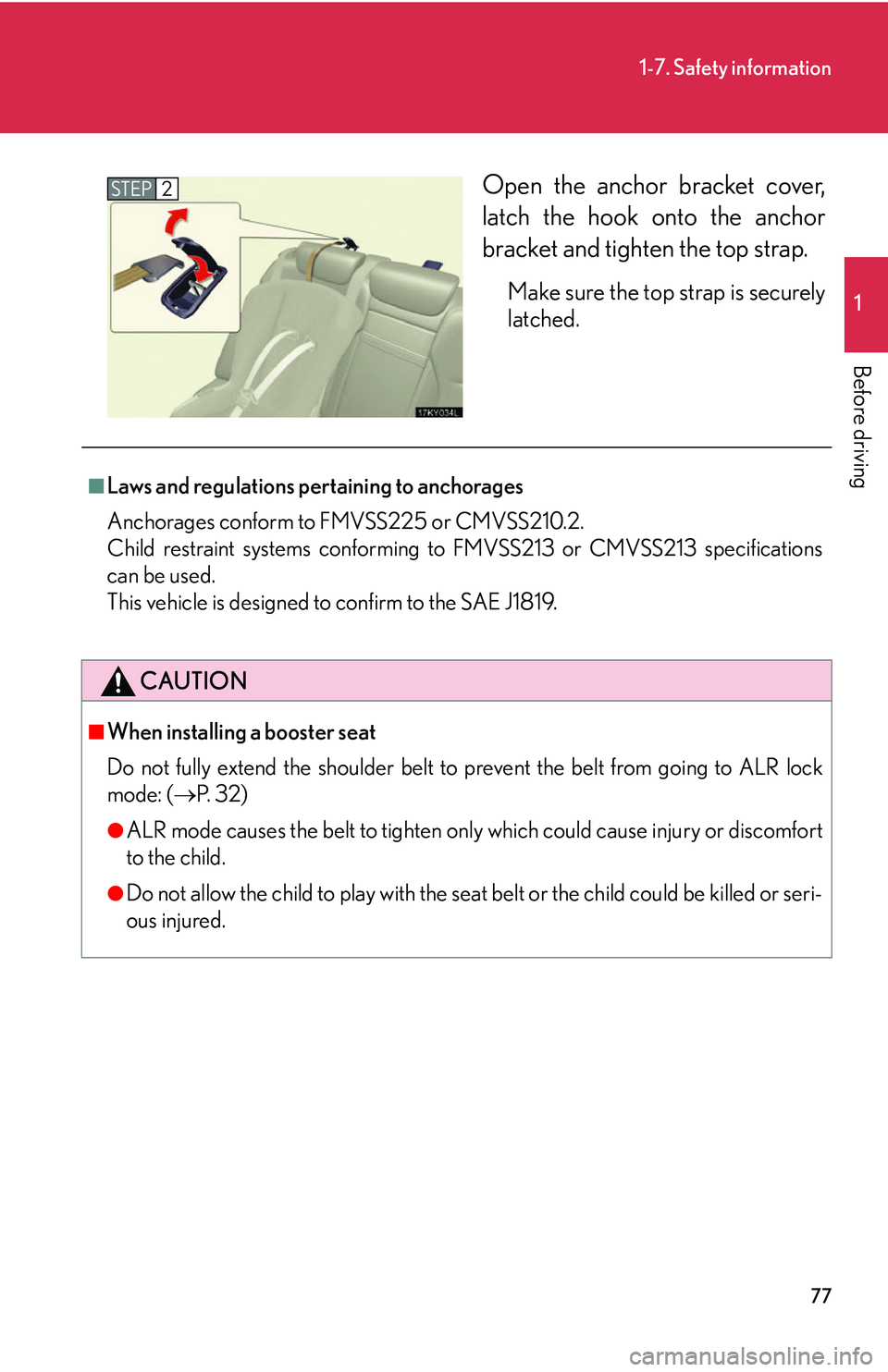
77
1-7. Safety information
1
Before driving
Open the anchor bracket cover,
latch the hook onto the anchor
bracket and tighten the top strap.
Make sure the top strap is securely
latched.
STEP2
■Laws and regulations pertaining to anchorages
Anchorages conform to FMVSS225 or CMVSS210.2.
Child restraint systems conforming to FMVSS213 or CMVSS213 specifications
can be used.
This vehicle is designed to confirm to the SAE J1819.
CAUTION
■When installing a booster seat
Do not fully extend the shoulder belt to prevent the belt from going to ALR lock
mode: ( P. 3 2 )
●ALR mode causes the belt to tighten only which could cause injury or discomfort
to the child.
●Do not allow the child to play with the seat belt or the child could be killed or seri-
ous injured.
Page 96 of 433

78
1-7. Safety information
CAUTION
■When installing a child restraint system
Follow the directions given in the child restraint system installation manual and fix
the child restraint system securely in place.
If the child restraint system is not correctly fixed in place, the child may be injured or
even killed in the event of sudden braking or an accident.
●When a booster seat is installed, always ensure that the shoulder belt is posi-
tioned across the center of the child's shoulder. The belt should be kept away
from the child's neck, but not so that it could fall off the child's shoulder. Failing to
do so may result in death or serious inju ry in the event of an accident or sudden
braking.
●Ensure that the belt and tab are securely locked and the seat belt is not twisted.
●Push and pull the child seat in different directions to be sure it is secure.
●Follow all installation instructions provid ed by the child restraint system manufac-
turer.
●If the driver’s seat interferes with the child
restraint system and prevents it from being
attached correctly, attach the child restraint
system to the right-hand rear seat.
●Only put a forward facing or booster child
seat on the front seat when unavoidable.
When installing a forward facing or
booster child restraint on the front passen-
ger seat, move the seat as far back as possi-
ble. Failing to do so may result in death or
serious injury if the airbags deploy (inflate).
Page 97 of 433
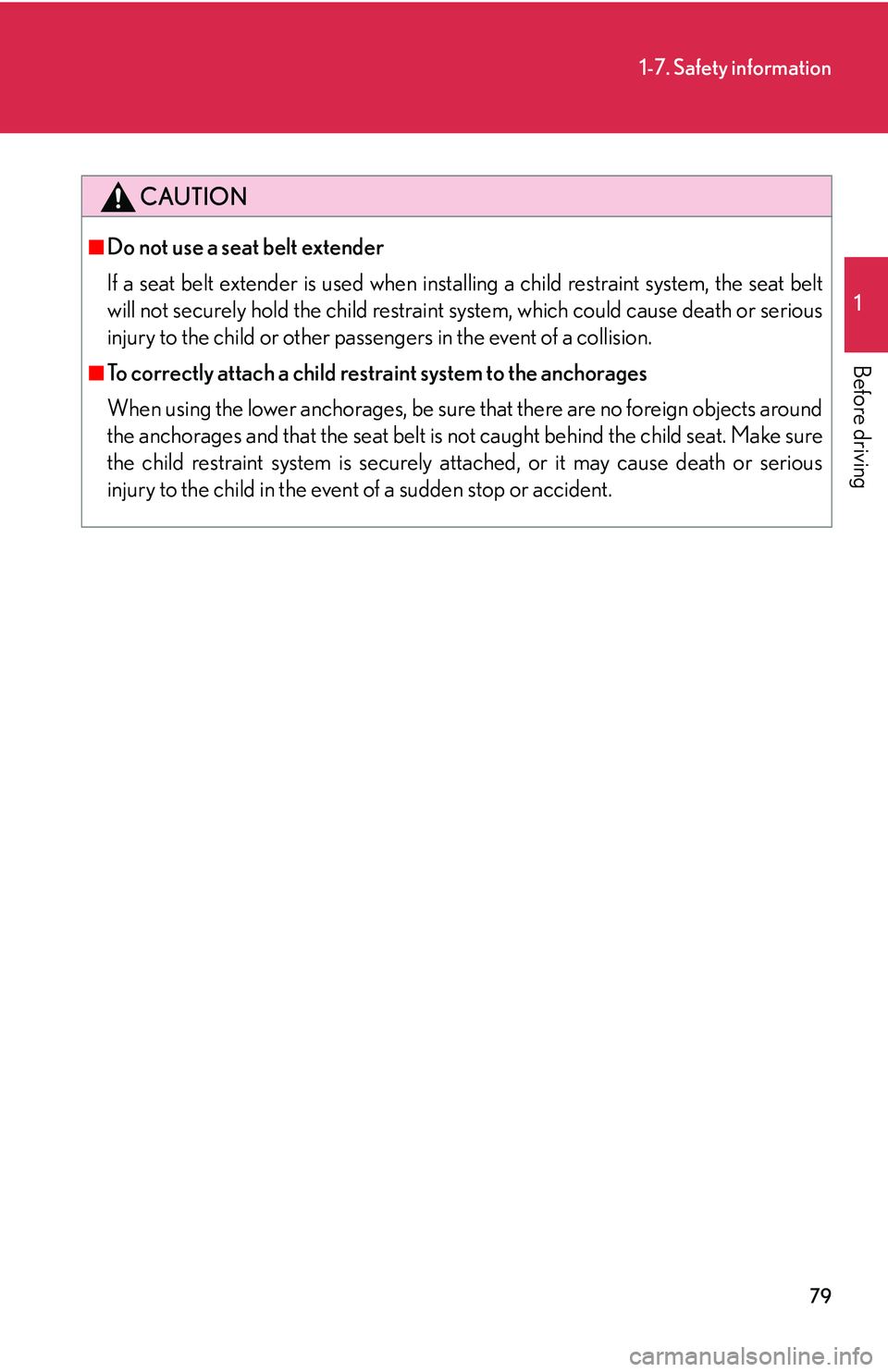
79
1-7. Safety information
1
Before driving
CAUTION
■Do not use a seat belt extender
If a seat belt extender is used when installing a child restraint system, the seat belt
will not securely hold the child restraint system, which could cause death or serious
injury to the child or other passengers in the event of a collision.
■To correctly attach a child restraint system to the anchorages
When using the lower anchorages, be sure that there are no foreign objects around
the anchorages and that the seat belt is not caught behind the child seat. Make sure
the child restraint system is securely at tached, or it may cause death or serious
injury to the child in the even t of a sudden stop or accident.
Page 98 of 433
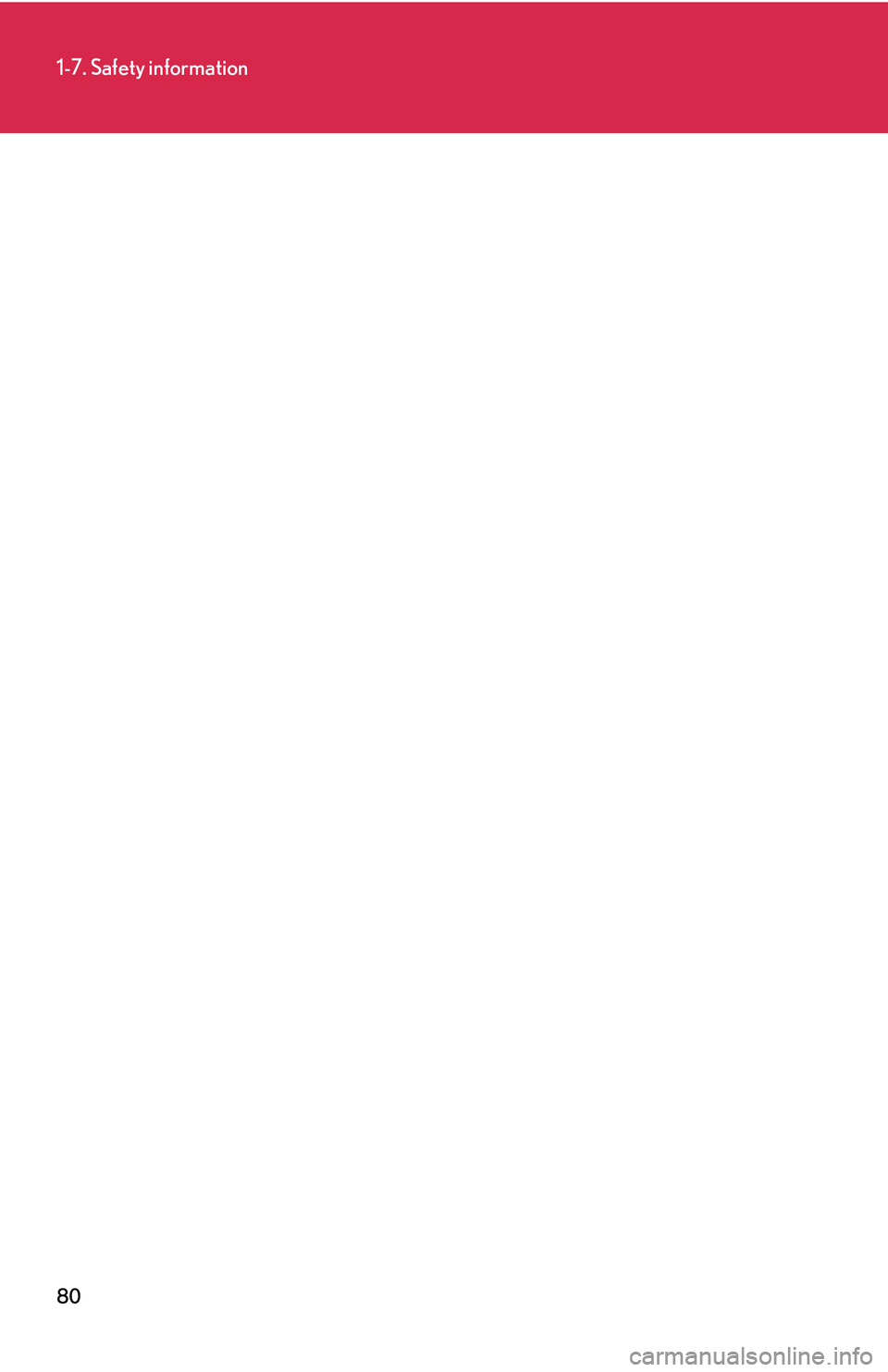
80
1-7. Safety information
Page 99 of 433
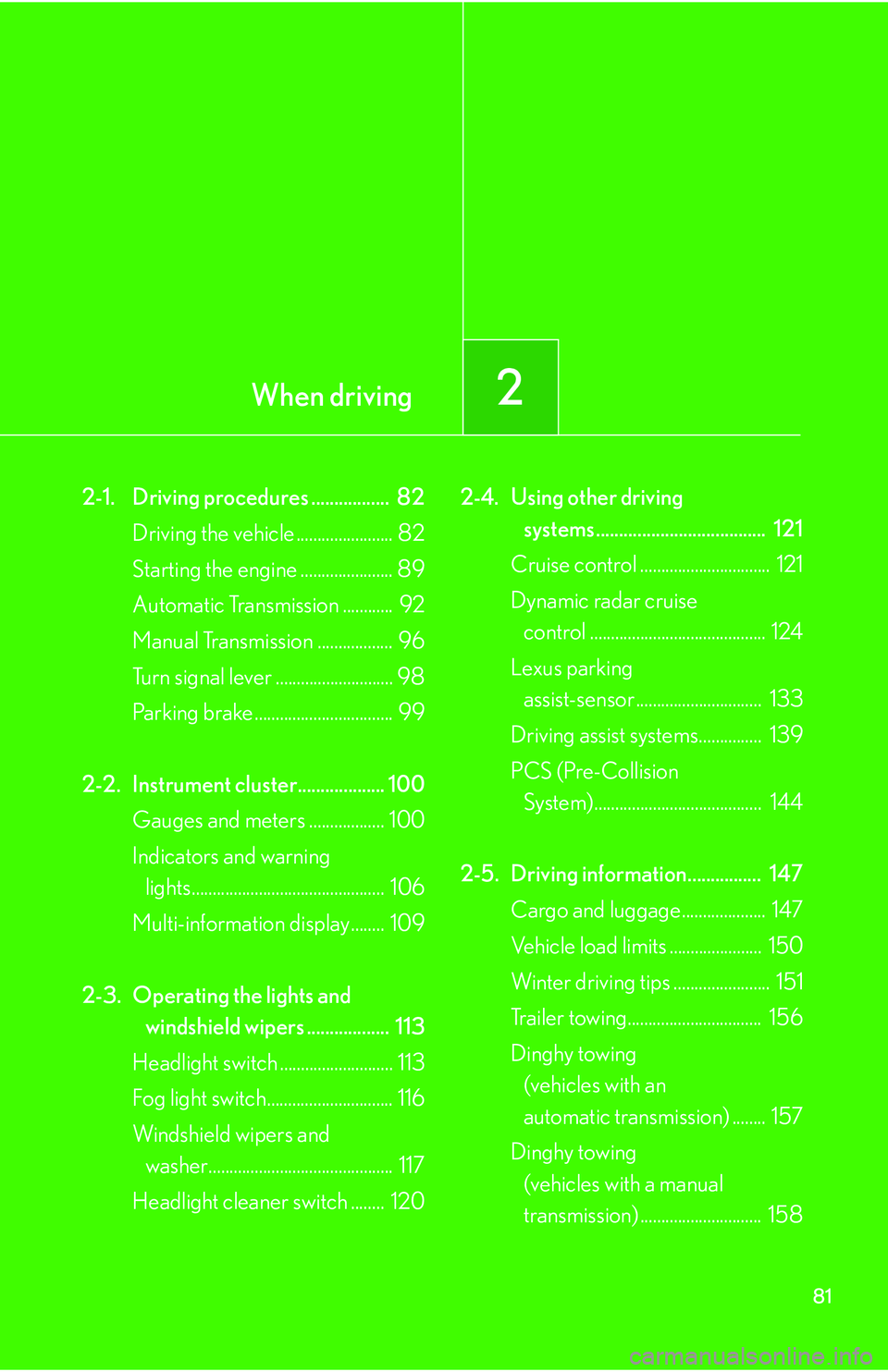
When driving2
81
2-1. Driving procedures ................. 82Driving the vehicle ....................... 82
Starting the engine ...................... 89
Automatic Transmission ............ 92
Manual Transmission .................. 96
Turn signal lever ............................ 98
Parking brake ................................. 99
2-2. Instrument cluster................... 100 Gauges and meters .................. 100
Indicators and warning lights.............................................. 106
Multi-information display........ 109
2-3. Operating the lights and windshield wipers .................. 113
Headlight switch ........................... 113
Fog light switch.............................. 116
Windshield wipers and washer............................................ 117
Headlight cleaner switch ........ 120 2-4. Using other driving
systems ..................................... 121
Cruise control ............................... 121
Dynamic radar cruise control .......................................... 124
Lexus parking assist-sensor .............................. 133
Driving assist systems............... 139
PCS (Pre-Collision System)........................................ 144
2-5. Driving information................ 147 Cargo and luggage.................... 147
Vehicle load limits ...................... 150
Winter driving tips ....................... 151
Trailer towing................................ 156
Dinghy towing (vehicles with an
automatic transmission) ........ 157
Dinghy towing (vehicles with a manual
transmission) ............................. 158
Page 100 of 433
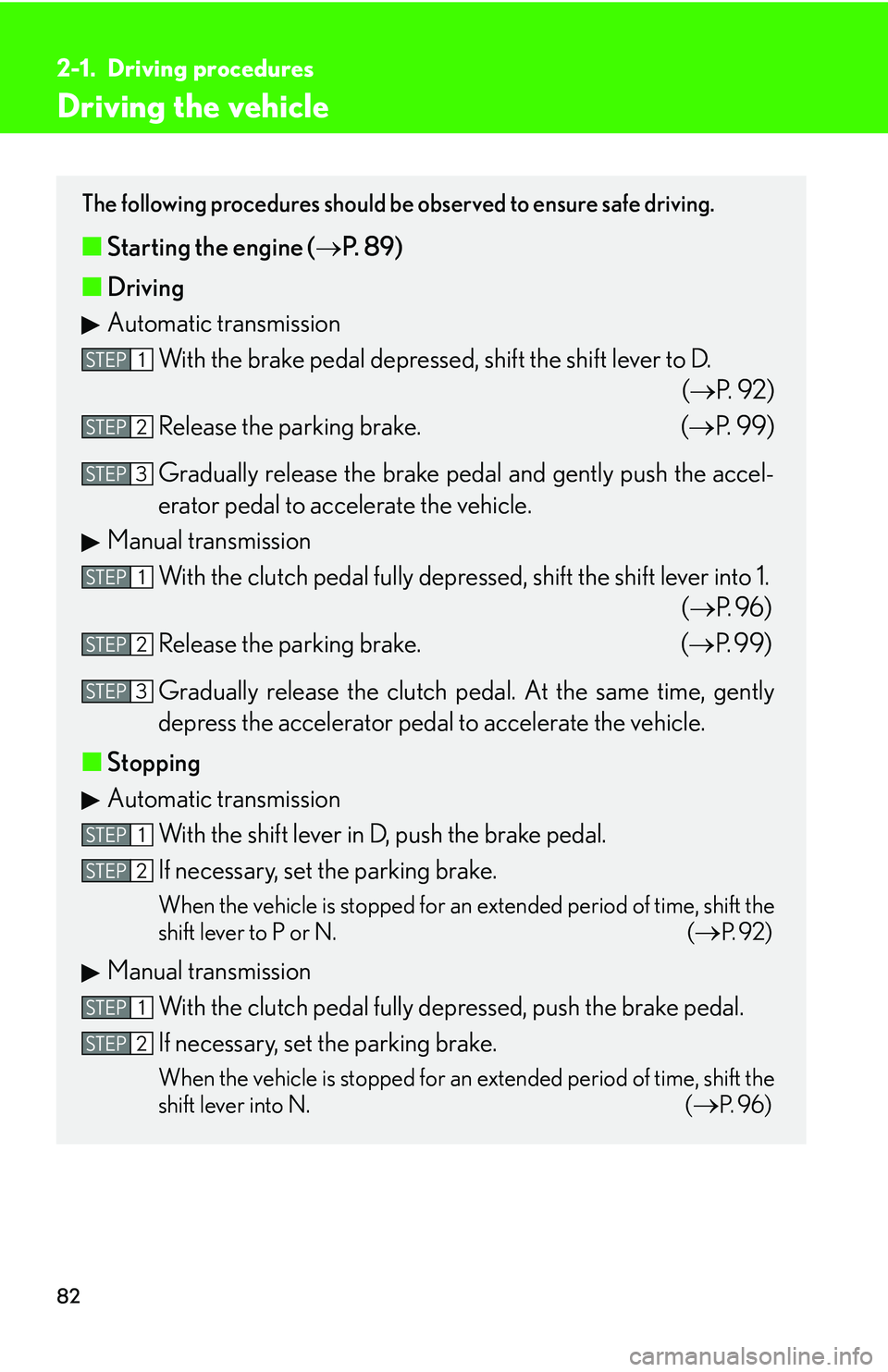
82
2-1. Driving procedures
Driving the vehicle
The following procedures should be observed to ensure safe driving.
■Starting the engine ( P. 8 9 )
■ Driving
Automatic transmission
With the brake pedal depressed, shift the shift lever to D. (P. 9 2 )
Release the parking brake. ( P. 99)
Gradually release the brake peda l and gently push the accel-
erator pedal to accelerate the vehicle.
Manual transmission
With the clutch pedal fully depressed, shift the shift lever into 1. (P. 9 6 )
Release the parking brake. ( P. 99)
Gradually release the clutch pedal. At the same time, gently
depress the accelerator pedal to accelerate the vehicle.
■ Stopping
Automatic transmission
With the shift lever in D, push the brake pedal.
If necessary, set the parking brake.
When the vehicle is stopped for an extended period of time, shift the
shift lever to P or N. (
P. 9 2 )
Manual transmissionWith the clutch pedal fully depressed, push the brake pedal.
If necessary, set the parking brake.
When the vehicle is stopped for an extended period of time, shift the
shift lever into N. (
P. 9 6 )
STEP1
STEP2
STEP3
STEP1
STEP2
STEP3
STEP1
STEP2
STEP1
STEP2